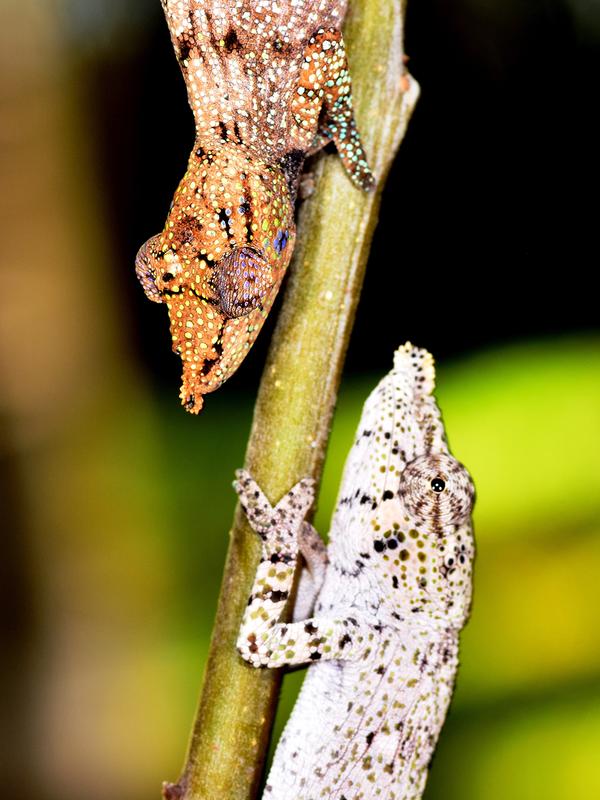Four new species of chameleons from Madagascar – revision of the „nosed-chameleons“

Two females of Calumma radamanus show territorial behavior when they meet due to their colorful displaying coloration. Photograph: David Prötzel (ZSM/LMU)
Madagascar is a paradise for nature lovers, since most of the land vertebrate species are only found on this large island off the east coast of Africa. The endemic lemurs and chameleons are of particular interest and biologists have been investigating these groups of animals intensively since the 19th century.
However, the taxonomy (classification) of many species is still unclear, as in the case of the flap-nosed chameleon Calumma nasutum, which was described as early as 1836.
Intensive fieldwork in partly remote forest areas from northern to southern Madagascar showed that these small chameleons with the “nasal appendage” that gives them their name actually represent a complex of several different species.
Using modern methods, including the examination of the skulls and the bizarre genital organs (hemipenes) by micro-computed tomography and the analysis of DNA sequences, three new species were finally named and described:
Calumma emelinae from the east coast of Madagascar, C. tjiasmantoi from the southeast, and C. ratnasariae from the north. Another species (C. radamanus) that had previously not been recognized was revalidated.
“Without the use of the different methods and the intensive field work this species complex would certainly not have been clarified yet. Only the combination of the different data sets has led to a significantly better understanding of the chameleon group”, says Dr. Frank Glaw, curator for amphibians and reptiles at the Bavarian State Collection of Zoology in Munich.
The new work represents the last missing piece in the puzzle of the Calumma nasutum group, which consisted of only seven species when the authors of the study started working on this group back in 2014.
This number has now more than doubled to 16 species. For the entire family of chameleons (Chamaeleonidae), this means an increase of over 4%.
“By revising the taxonomy of the entire Calumma nasutum group, not only the protection status of the new species but also that of the already known species has to be re-evaluated,” says Dr. David Prötzel, first author of the study and former doctoral student at the Ludwig-Maximilians University in Munich and the Bavarian State Collection of Zoology, “numerous species are probably endangered and depend on the protection of their habitats.”
Dr. David Prötzel
Phone: 0176 63200513
E-Mail: david.proetzel@mail.de
Dr. Frank Glaw
SNSB – Zoologische Staatssammlung München
Münchhausenstraße 21, 81247 München
Phone: 089 8107 114
E-Mail: glaw@snsb.de
Prötzel, D., Scherz, M.D., Ratsoavina, F.M., Vences, M., Glaw, F. (2019). Untangling the trees: Revision of the Calumma nasutum complex (Squamata: Chamaeleonidae). Vertebrate Zoology, 70(1): 23-59. https://doi.org/10.26049/VZ70-1-2020-3
http://www.zsm.mwn.de – Zoologische Staatssammlung München
http://www.snsb.de – Staatliche Naturwissenschaftliche Sammlungen Bayerns
Media Contact
All latest news from the category: Life Sciences and Chemistry
Articles and reports from the Life Sciences and chemistry area deal with applied and basic research into modern biology, chemistry and human medicine.
Valuable information can be found on a range of life sciences fields including bacteriology, biochemistry, bionics, bioinformatics, biophysics, biotechnology, genetics, geobotany, human biology, marine biology, microbiology, molecular biology, cellular biology, zoology, bioinorganic chemistry, microchemistry and environmental chemistry.
Newest articles

High-energy-density aqueous battery based on halogen multi-electron transfer
Traditional non-aqueous lithium-ion batteries have a high energy density, but their safety is compromised due to the flammable organic electrolytes they utilize. Aqueous batteries use water as the solvent for…

First-ever combined heart pump and pig kidney transplant
…gives new hope to patient with terminal illness. Surgeons at NYU Langone Health performed the first-ever combined mechanical heart pump and gene-edited pig kidney transplant surgery in a 54-year-old woman…

Biophysics: Testing how well biomarkers work
LMU researchers have developed a method to determine how reliably target proteins can be labeled using super-resolution fluorescence microscopy. Modern microscopy techniques make it possible to examine the inner workings…





















